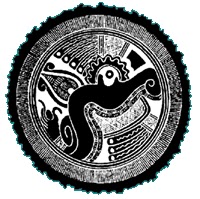Human nature drives us to want to acquire things that are beautiful. We can't be satisfied to see a beautiful object in nature and then leave it there. For instance, some kinds of Nicaraguan wildlife are subject to the willfulness of humans to treat wild animals as objects that can be bought and sold.
Macaws are the largest members of the New World Parrot family (Psittacidae); they are spectacular, gregarious, and "smart" birds. Two species of this group are found in nature in Nicaragua: the Scarlet Macaw (
Ara macao), and the Great Green Macaw (
Ara ambiguus, previously named
Ara ambigua). The Nicaraguan populations of both these species have suffered greatly because of the pet trade.
 |
| This is a Scarlet Macaw (Ara macao), which has been subjected to coloration, through chemicals such as hydrogen peroxide, to make it appear to be something even more exotic. Sale of these majestic animals should be banned, as well as mistreatment by processes such as feather bleaching. Photo by Matthias Geiger. |
Scarlet Macaws (
Ara macao) no longer inhabit almost all of the Pacific region of Nicaragua, thanks to the illicit pet trade. This species is listed on CITES Appendix I, which means, basically, that it is quite difficult to export an individual. In spite of the ban on international trade, Scarlet Macaws are much easier found on tethered to sticks on roadsides than in the skies overhead, in Nicaragua. There is a robust trade and virtually no prosecution of pet owners. Many birds find their way to small watercraft which transit contraband from Nicaragua to the much wealthier neighbor, El Salvador, where the birds bring much more money. A Scarlet Macaw in good condition in Nicaragua can cost much more than five hundred dollars.
.jpg) |
| Bumbelina is a pet rescue, Great Green Macaw (Ara ambiguus). She is receiving care at Estacion Biologica in Laguna de Apoyo Nature Reserve. Photo by Joyce Procure. |
We have handled a number of
rescue animals over the years at Estacion Biologica. Most of these animals have been taken from people who captured them for use as pets, or the animals have been found injured in or around Laguna de Apoyo Nature Reserve. When we have a little success, the animals survive, heal, and eventually, return to the wild. Not all can heal and return to the wild, however. One pet rescue bird in
Estacion Biologica FUNDECI/GAIA, is a
Great Green Macaw (
Ara ambiguus). Its native range is considerably more limited than that of the Scarlet Macaw. The majority of the birds of this species are found in southeastern Nicaragua, where jungles are thick and rain is practically year-round. Bumbelina is a female, like her fellow rescue Scarlet Macaw, Midorna. Bumbelina is very angry and aggressive, and large and heavy, so she is best admired from a safe distance!
The
Great Green Macaw is Endangered and is also listed on CITES Appendix I. Nonetheless, current law enforcement does not prevent the ownership of these birds inside Nicaragua, and they can be found in many homes.
.jpg) |
| Bumbelina was captured in the wild, and her injuries were severe from the brutal mistreatment. She still dreams of flight, but her amputated right wing prevents her from ever returning to the wild. Photo by Joyce Procure. |
Midorna is a
Scarlet Macaw, also a pet rescue living at
Estacion Biologica Laguna de Apoyo. Bumbelina weighs about twice Midorna, much bulkier with a much heavier bill and larger claws, but the two birds make great friends. Like Bumbelina, she has been mistreated in captivity, and her permanently injured wing prevents her from taking flight. During her lifetime of incarceration in a cage, she has developed a feather-plucking disorder, making her look much less majestic than she would look if living in the wild. We are hoping that her feather plucking will reduce with lots of activity and contact. The two birds are destined for delivering the message that
wild animals deserve to be free, not in cages! They will be visiting schools and social events around our area, throughout 2013.
 |
| Midorna is affectionate with those whom she trusts. Photo by Joyce Procure. |
As lovers of nature, we are disturbed by the illegal traffic in wild animals. Our desire to "own" a beautiful bird has harmed many birds, and their loud screeches are no longer heard in much of the forests they once inhabited. Would you like to help us prevent the capture and trade in endangered wild animals in
Nicaragua? There is plenty to do. Please
contact us!
.jpg)



.jpg)
No comments:
Post a Comment